Dietary Solutions for Cats with Bladder Crystals
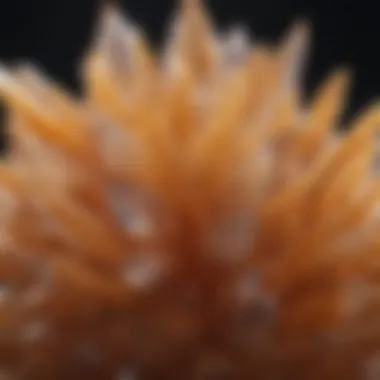
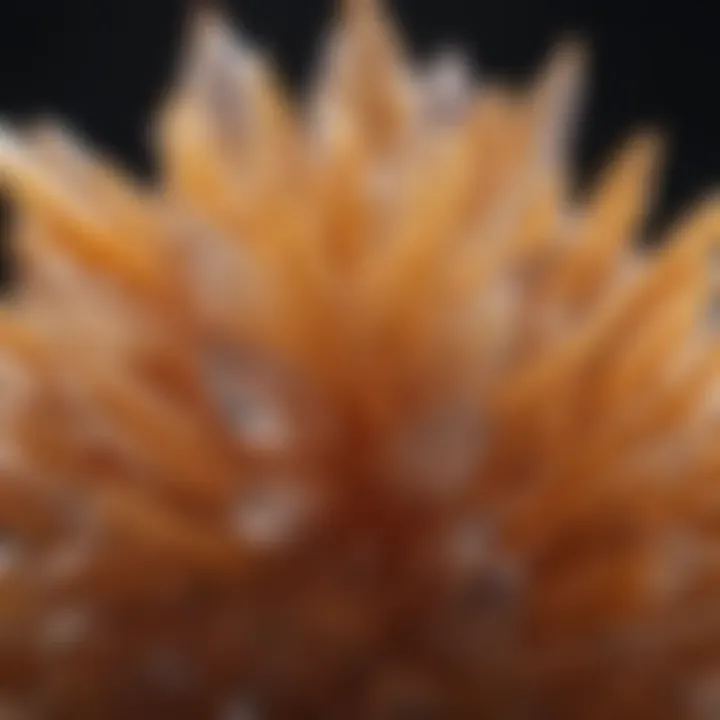
Intro
Understanding the dietary needs of cats, particularly those suffering from bladder crystals, is crucial for their health and well-being. Pet owners must grasp the significance of diet in relation to crystal formation and urinary health. This article will provide insights into the types of bladder crystals that can affect cats, the nutritional adjustments needed, and effective strategies for preventing recurrence. The aim is to equip you with the knowledge necessary to make informed decisions for your feline companion.
Understanding Your Pet
Breed Traits
Different cat breeds may have unique susceptibilities to bladder crystals. For instance, breeds like the Burmese and Siamese are noted to show higher instances of urinary issues. Understanding the specific traits of your breed can aid in tailoring their diet to reduce the risk of crystal formation.
Common Temperaments
Cats display various temperaments that can influence their overall stress levels and, consequently, their urinary health. Stress can trigger or exacerbate bladder issues, so it is beneficial to be aware of your cat's behavior. Calm cats may be less prone to such complications compared to more anxious individuals.
Special Needs
Some cats may require special dietary considerations due to existing health conditions. If your cat has a history of urinary tract issues, consulting with a veterinarian would be prudent. They can recommend specific foods that promote urinary health, such as those designed for the management of bladder crystals.
Pet Care Essentials
Nutrition and Feeding Guidelines
A balanced diet is foundational for cats with bladder crystals. Consider foods that are high in moisture content, as hydration plays a pivotal role in flushing out the urinary tract. Options like Hill's Prescription Diet c/d Multicare and Royal Canin Urinary SO are designed to dissolve certain types of crystals. Always check for the specific ingredients and consult your veterinarian for the best options tailored to your cat’s needs.
Grooming Tips and Techniques
While grooming does not directly influence bladder health, keeping your cat well-groomed can reduce overall stress levels and promote a positive environment. Regular brushing helps prevent matting and hairballs, making your cat feel more comfortable.
Health and Wellness
Regular veterinary check-ups are essential. Maintaining a schedule can help you monitor any changes in your cat’s health. During these visits, your vet can advise on nutrition and other care aspects relevant to bladder health.
Training and Behavior
Basic Training Techniques
Implementing basic training can help manage your cat’s behavior, reducing stress that might contribute to urinary issues. Employ positive reinforcement methods, like treats or affection, to encourage desirable behaviors.
Behavioral Problems and Solutions
Common behavioral problems, such as inappropriate urination, often stem from stress or medical conditions. Observing your cat’s habits can lead you to solutions, whether through adjustments to their environment or dietary changes.
Mental Stimulation Activities
Providing mental stimulation is vital. Engaging your cat with puzzles or interactive toys can help mitigate stress and promote a relaxed demeanor, benefitting their overall health.
Engaging with Your Pet
Interactive Games and Toys
Investing in interactive games will keep your cat physically active. Toys like feather wands or laser pointers not only provide exercise but also mental engagement.
Safe Outdoor Activities
If feasible, take your cat on safe outdoor excursions. Supervised outdoor experiences in a secure environment can enrich their life and reduce anxiety.
Family-Friendly Pet Interactions
Involving family members in pet care fosters a positive atmosphere for your cat. Teaching children the proper way to interact with the pet can enhance the bond and decrease stress.
Pet Adoption and Integration
Choosing the Right Pet for Your Lifestyle
When considering adopting a cat with health issues, be honest about your ability to provide the necessary care. This includes understanding dietary requirements that reduce bladder-related problems.
Preparing Your Home for a New Pet
Ensure your home is accommodating for a cat with specific health needs. This includes setting up a quiet space and providing easy access to the litter box and food.
Tips for Smooth Prolusion
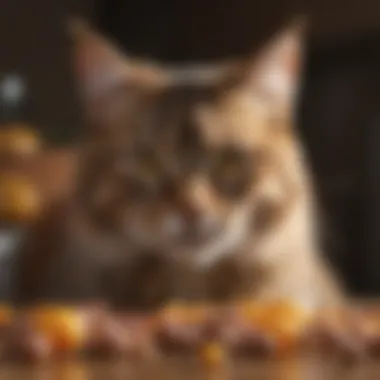
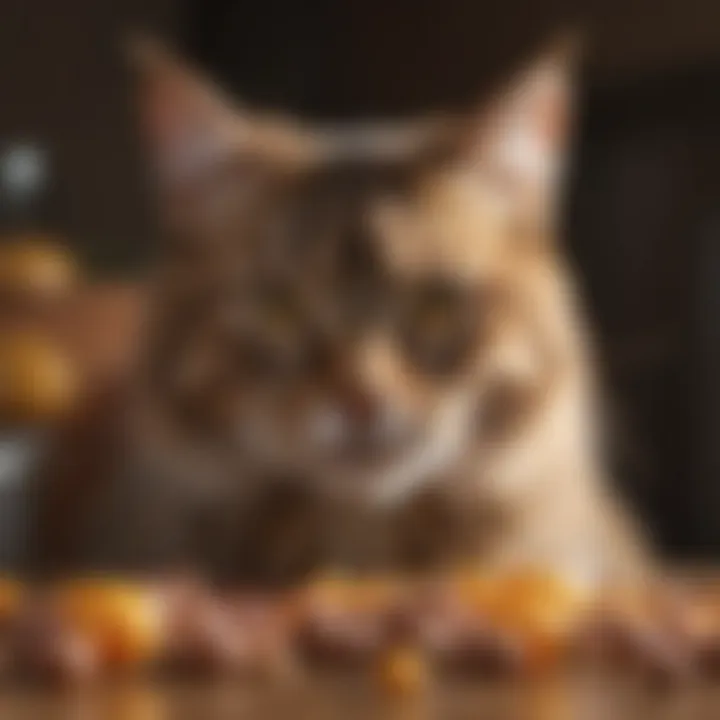
Introducing a new cat into your home should be gradual. Allow them to acclimate to their new environment at their own pace, which can help reduce potential stress and urinary issues.
Notable Insight: Regular check-ups and a well-balanced diet are essential components in managing bladder health for cats suffering from crystals.
This information provides a comprehensive understanding of the elements involved in maintaining the health of a cat with bladder crystals. Adopting the right dietary practices and lifestyle habits helps ensure a brighter future for your pet.
Preface to Bladder Crystals in Cats
Understanding bladder crystals in cats is crucial for ensuring their health and well-being. These crystals can lead to serious urinary issues, including infections and blockages. Recognizing the factors that contribute to their formation helps pet owners take proactive steps in managing their cat's diet and lifestyle choices. This section introduces key elements about bladder crystals, emphasizing the role of diet in prevention and treatment.
Defining Bladder Crystals
Bladder crystals are solid particles that form in the urinary tract of cats. They are the result of mineral buildup and can lead to painful conditions when left untreated. By defining bladder crystals, we can start to understand why certain diets may help or hinder their development. Crystals can come in various types, each presenting unique challenges. Understanding these nuances is critical for effective management.
Common Types of Bladder Crystals
Bladder crystals can vary significantly in composition and behavior. The most common types include:
Struvite Crystals
Struvite crystals are mainly composed of magnesium, ammonium, and phosphate. They often form in alkaline urine and are typically associated with urinary tract infections. Struvite crystals are important to recognize because they can sometimes dissolve with appropriate dietary changes. A diet lower in phosphorus and protein may help to prevent their formation. However, owners should monitor the urine pH levels closely, as too much alkalinity can promote these crystals.
Calcium Oxalate Crystals
Calcium oxalate crystals are a frequent issue in cats and form in acidic urine. Unlike struvite crystals, these do not dissolve with dietary changes. Instead, they require long-term dietary management and intervention. Diets moderate in calcium and oxalate are usually beneficial. When owners observe signs of discomfort or straining, they should consult a vet. Owners need to understand this type since it often leads to more severe health issues.
Urate Crystals
Urate crystals result from high levels of uric acid and often appear in cats with liver issues or certain metabolic disorders. They tend to form in acidic urine and require specific dietary measures to manage. Reducing protein levels and choosing high-quality protein sources can be beneficial. Awareness of this type is vital, as it may indicate underlying health problems that warrant further investigation.
Symptoms and Diagnosis
Recognizing clinical signs related to bladder crystals can lead to timely interventions. Common symptoms may include frequent urination, blood in urine, or straining to urinate. Identifying these early signs facilitates faster diagnosis and treatment.
Recognizing Clinical Signs
Recognizing clinical signs is fundamental because many symptoms are not immediately obvious. Pet owners may notice changes in their cat's behavior, such as increased grooming around the genital area or frequent trips to the litter box. These signs can indicate discomfort, making monitoring crucial. Early detection enhances treatment success, leading to better outcomes for the cat.
Diagnostic Testing Procedures
Diagnostic testing involves urinalysis and possibly imaging to identify the presence of crystals. This testing is essential for determining the specific type of crystal and devising a proper management plan. By understanding the diagnostic protocols, pet owners can engage more effectively with their veterinarians and ensure necessary tests are performed. Accurate diagnosis minimizes complications and tailors treatment effectively.
The Role of Diet in Urinary Health
Understanding the role of diet in urinary health is vital for pet owners who want to support their cats suffering from bladder crystals. Nutrition has a direct impact on the formation of crystals, which can lead to serious health issues. By modifying what your cat eats, you can potentially prevent the development of crystals and promote better urinary health overall. Specific dietary components work together to influence urine acidity, water intake, and mineral levels. All these aspects are essential in managing bladder health and keeping your cat comfortable.
Nutritional Influences on Crystal Formation
The type of diet can significantly influence whether crystals form in a cat's urinary system. Different nutrients can either exacerbate or help prevent crystal formation. For example, high magnesium levels are often linked to struvite crystals, while calcium oxalate crystals are influenced by excess calcium and oxalate in the diet. Understanding these dynamics allows pet owners to make informed choices about their cat’s meals. A careful balance of nutrients is, therefore, necessary to maintain optimal urinary health.
Essential Nutrients for Prevention
Adequate Water Intake
Adequate water intake is one of the cornerstone aspects of maintaining urinary health in cats. Hydration helps dilute urine, reducing the concentration of minerals that can lead to crystal formation. A well-hydrated cat is less likely to develop urinary issues. Increasing water consumption is usually a popular choice for owners looking to support their cats’ health. You can encourage hydration in various ways such as providing fresh water daily or using water fountains. This can be a game changer for sensitive cats and may greatly enhance their overall well-being.
Balanced Protein Sources
Balanced protein sources are crucial in a cat's diet, particularly when addressing bladder crystals. Proteins provide essential amino acids that influence urine pH. A diet that includes high-quality, animal-based proteins tends to be more beneficial. It helps maintain a healthy urinary system by ensuring that relevant nutrients are present without overloading the system with excess nitrogen and minerals. Lean meats and fish are strong candidates for serving as balanced protein sources. However, excessive protein can be an issue, so monitoring is necessary.
Appropriate Mineral Levels
Appropriate mineral levels play a significant role in urinary health. Minerals such as phosphorus, calcium, and magnesium need to be balanced carefully. An excessive amount of these minerals may contribute to the formation of crystals. Therefore, diets that focus on ideal mineral ratios are highly beneficial. By selecting cat food with lower levels of certain minerals, owners can help manage their pets’ urinary health more effectively. Always consult a vet for proper recommendations based on specific health needs.
The combination of adequate water intake, balanced protein sources, and appropriate mineral levels is essential for preventing bladder crystals in cats.
Specialized Commercial Diets
Specialized commercial diets play a crucial role in managing bladder crystals in cats. These diets are specifically formulated to address the unique nutritional needs of felines with urinary conditions. A proper diet can help dissolve certain types of bladder crystals and prevent their recurrence, making it an essential consideration for pet owners seeking to improve their cat's urinary health.
Overview of Commercial Options
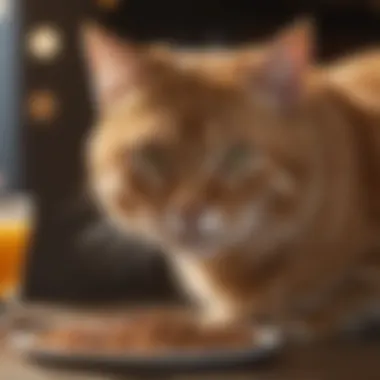
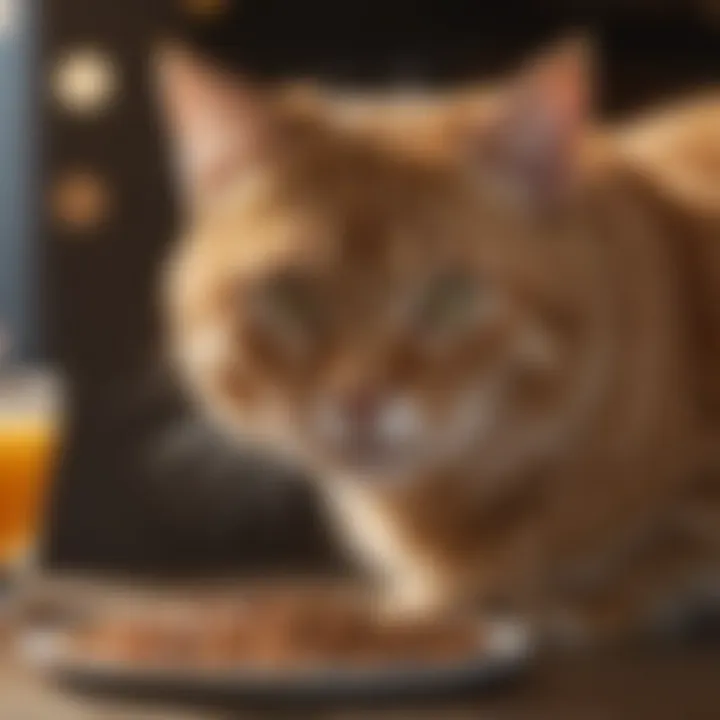
When exploring commercial diets for cats with bladder crystals, pet owners have various options available. These diets typically fall into different categories based on their formulation and intended use. It is important to know which products are designed to help with urinary health.
Here are some common types of specialized commercial diets:
- Urinary Health Formulas: Many brands offer formulations specifically designed to support urinary tract health. These diets often contain adjusted levels of protein, minerals, and moisture.
- Prescription Diets: Available through veterinarians, these diets are tailored for specific urinary conditions and require a vet's approval for use.
- Natural and Grain-Free Options: Some brands offer natural ingredients that may appeal to pet owners looking for alternatives without synthetic additives.
Cats often respond well to these specialized diets. However, consultation with a veterinarian is essential to determine the best fit for your cat’s specific needs.
Prescription Diets for Bladder Crystals
Prescription diets serve as a reliable option for cats diagnosed with bladder crystals. These diets are backed by research and designed to address specific urinary conditions. They often dilute urine and alter pH levels, which can help dissolve struvite crystals and prevent the formation of calcium oxalate crystals.
Most notably, prescription diets can lead to improved urinary outcomes. Cats on these diets usually show a decrease in urinary issues. Some popular brands include Hill's Prescription Diet c/d Multicare and Royal Canin Urinary SO. It is crucial to follow the veterinarian's directives when introducing these diets to ensure effectiveness and monitor the cat's health.
Evaluating Ingredients in Cat Food
When selecting a commercial diet for cats with bladder crystals, understanding the ingredients is vital. Assessing the ingredients helps pet owners make informed choices about their cat's food. Here are some key factors to consider:
- Protein Sources: Opt for high-quality sources such as chicken or fish. These support muscle maintenance and overall health.
- Mineral Content: Look for diets with controlled levels of magnesium, phosphorus, and calcium. These minerals influence crystal formation in the urine.
- Moisture Content: Wet food is often recommended as it increases hydration. An optimal approach would involve products with at least 70% moisture content to aid urinary health.
Diets that are high in moisture may help reduce the concentration of minerals in urine, lowering the likelihood of crystal formation.
By scrutinizing these elements, pet owners can better select diets aligning with their cats' health requirements, contributing to their overall well-being.
Homemade Diets for Cats with Bladder Crystals
Homemade diets for cats with bladder crystals offer a personalized approach to managing your pet's urinary health. Preparing food at home allows pet owners to have control over the ingredients used, ensuring that they comply with specific dietary needs. Commercial cat food can sometimes be insufficient in addressing the unique requirements of felines with crystal complications. Therefore, reverting to a more natural, homemade option may yield benefits in improving urinary health and overall well-being.
Advantages of Home-Cooked Meals
There are several advantages to opting for home-cooked meals for cats suffering from bladder crystals. Firstly, you can customize the nutritional content to fit your cat's individual needs. This customization is particularly important when dealing with the various types of crystals like Struvite or Calcium Oxalate. Secondly, home-cooked meals often use high-quality ingredients, minimizing preservatives and fillers that are common in commercial pet foods. Furthermore, the freshness of homemade food can greatly enhance palatability, making meals more appealing to your cat.
- Quality Control: You choose fresh, natural ingredients.
- Reduced Risk of Allergens: Tailor the diet to avoid allergens.
- Enhanced Palatability: Home-cooked meals may be more appealing to the cat.
Key Ingredients for DIY Cat Food
When preparing homemade diets, some key ingredients should be prioritized to ensure optimal urinary health. Cats require a specific balance of nutrients to not only maintain their health but also to help prevent the formation of bladder crystals. Here are some essential components to consider:
- Lean Protein Sources: Chicken, turkey, or fish provide the necessary proteins while being low in ash content, which influences crystal formation.
- Hydrating Ingredients: Incorporating ingredients with high water content, like pumpkin or squash, can help increase fluid intake indirectly.
- Essential Fatty Acids: Omega-3 and Omega-6 fatty acids, often found in fish oil, are beneficial for inflammation and keeping the urinary tract functioning well.
Sample Recipes for Urinary Health
Here are some simple recipes you can use to create nutritious meals for your cat. Always consult with a vet before making significant changes to your pet's diet.
Recipe 1: Chicken and Pumpkin Blend
- Mix all ingredients thoroughly and serve at room temperature. Store leftovers in the fridge for up to three days.
Recipe 2: Fish Rice Medley
- Combine all ingredients and serve. This recipe also stores well for short periods.
Preparing these simple meals at home can contribute to your cat's overall urinary health, particularly for those with a history of bladder crystal issues.
Hydration and Its Importance
Hydration plays a crucial role in managing bladder crystals in cats. Water is essential for the proper functioning of the urinary system. Insufficient hydration can lead to concentrated urine, which in turn fosters the formation of bladder crystals. Thus, ensuring that a cat stays well-hydrated is a fundamental aspect of dietary considerations aimed at improving urinary health.
Understanding Cat Hydration Needs
Cats have a naturally low thirst drive compared to other animals. They evolved from ancestors who primarily obtained moisture through their prey. As a result, many domestic cats do not drink sufficient water, especially if their diet consists mainly of dry food. It is vital to recognize that a properly hydrated cat typically exhibits clear or pale urine.
Some cats may require more water depending on factors such as age, activity level, and overall health. Older cats or those with mobility issues often drink less. In contrast, active younger cats might need more fluids. A general guideline suggests that a cat should consume around 3.5 to 4.5 ounces of water per 5 pounds of body weight daily. Keeping track of a cat's drinking habits can assist in detecting any potential hydration issues early on.
Techniques to Enhance Water Intake
Giving regular fresh water to a cat is essential, but there are various methods to encourage them to drink more. Here are some effective techniques to enhance a cat's water intake:
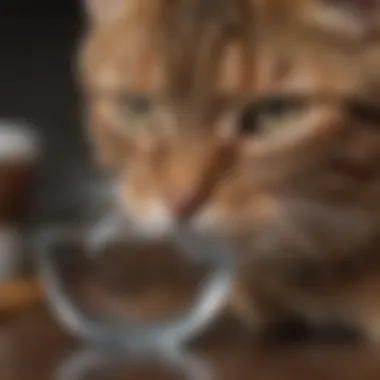
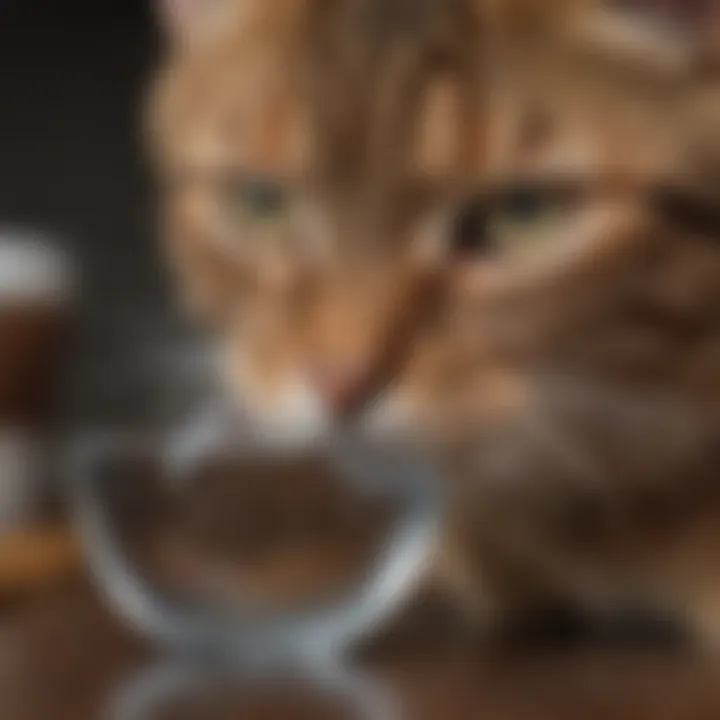
- Provide Fresh Water Daily: Change the water at least once a day to keep it appealing. Cats tend to prefer fresh water.
- Utilize Cat Fountains: Many cats are attracted to moving water. Investing in a pet fountain might entice them to drink more.
- Incorporate Wet Food: Including wet food in the diet is an effective means to increase overall fluid intake. Wet food can contain up to 80% moisture.
- Add Water to Dry Food: Mixing a little bit of water into dry kibble can enhance the moisture content and encourage drinking.
- Flavor Water: Adding a small amount of low-sodium chicken broth to the water can make it more enticing for the cat.
- Monitor Water Bowls: Use multiple water bowls in different locations, which may encourage cats to drink more, especially if they are shy or territorial.
Research indicates that a well-hydrated cat is significantly less likely to experience urinary complications, including bladder crystals.
Monitoring these techniques can lead to better hydration management and support the prevention of bladder crystal formation.
Impact of Lifestyle on Bladder Health
The lifestyle of a cat significantly influences bladder health. Understanding these elements is crucial for pet owners aiming to manage or prevent bladder crystals. A cat's daily routines, from physical activity to environmental factors, can shape urinary health more than one might expect. These considerations not only help in preventing the onset of bladder crystals but also in ensuring a cat's overall well-being.
Physical Activity and Urinary Function
Engaging in regular physical activity plays an essential role in maintaining a cat’s urinary function. Active cats tend to have healthier diets and better hydration. Exercise stimulates metabolism, leading to increased water intake and consequently healthier urine production. An adequate fluid intake is critical since it dilutes urine and reduces the probability of crystal formation.
Some simple ways to enhance physical activity include:
- Interactive toys: Encourage exploration and play.
- Scheduled playtime: Regular sessions stimulate movement.
- Climbing structures: These not only cater to natural instincts but promote exercise.
Moreover, a fit cat is less likely to develop obesity-related health issues. Obesity can complicate urinary health by limiting mobility, further diminishing fluid intake and leading to concentrates urine. Therefore, maintaining a healthy weight through activity is critical.
Environmental Factors Influencing Crystals
Cats’ environments can have profound impacts on their health, especially concerning bladder crystals. Factors like litter box cleanliness, access to fresh water, and stress management can be pivotal. A cat's surroundings should be conducive to both hydration and a stress-free life.
Here are several considerations for a healthy environment:
- Clean litter boxes: Regular cleaning encourages litter usage and reduces stress.
- Multiple water sources: Cats may be more inclined to drink if water is readily available in various locations.
- Stress reduction: High-stress environments can contribute to urinary issues. Creating a calm space is advisable.
Regular Health Monitoring and Vet Consultations
Regular health monitoring and vet consultations are crucial aspects for cat owners dealing with bladder crystals. Maintaining a watchful eye on your cat's health can preempt serious issues. The formation of bladder crystals can be influenced by various factors like diet, hydration, and overall health. Routine check-ups with a veterinarian provide an opportunity to catch potential problems early.
Routine visits allow for a professional assessment of your cat's health status. During these appointments, veterinarians can conduct necessary diagnostic tests and provide guidance on appropriate dietary adjustments. By leveraging their expertise, pet owners can make informed decisions that directly affect their cat's urinary health. In addition, regular vet visits help in understanding how well a specific diet is working and whether modifications are needed.
It is essential to prioritize routine check-ups as they can significantly impact your cat's quality of life and overall health.
Regular health monitoring helps identify any changes in behavior or physical condition. Pet owners should be observant of their cats, as subtle shifts can be indicative of underlying issues. Early intervention is key to preventing severe complications and ensuring optimal health.
The Importance of Routine Check-Ups
Routine check-ups serve multiple functions. First, they hold the potential to identify new or recurring health concerns related to bladder crystals. Early detection of issues like struvite or calcium oxalate crystals can lead to timely interventions that mitigate discomfort and potential health risks.
Second, exams allow for the evaluation of the effectiveness of a cat's current diet. Providing the right nutrition tailored to minimize the risk of crystal recurrence is vital for care. Your veterinarian can suggest adjustments based on your cat's weight, age, and lifestyle.
Moreover, these visits enable discussions about hydration strategies, as adequate fluid intake is essential for crystal prevention. Vets can recommend feeding practices and treat options known to keep cats hydrated and healthy. Thus, regular check-ups impact more than just immediate health—they can inform long-term dietary strategies.
Signs of Recurrence to Monitor
Monitoring for recurrence is an essential task for cat owners. There are specific symptoms that can signal the return of bladder crystals. Knowing these signs can help you act quickly and seek veterinary attention.
- Increased urination frequency: Cats may urinate more often if experiencing discomfort from crystals. This can manifest as straining to urinate or small amounts being produced at a time.
- Changes in litter box habits: A noticeable change in how your cat uses the litter box may indicate a problem. If your cat avoids the litter box or acts distressed while trying to urinate, it may be time for a vet visit.
- Blood in urine: The presence of blood can be distressing and is a serious concern. This sign often necessitates immediate consultation with a veterinarian.
- Signs of pain or discomfort: Limping, vocalization while urinating, or changes in behavior suggest that your cat is experiencing pain and needs evaluation.
By being aware of these signs, you empower yourself to take action before the situation worsens. Prompt discussions with your veterinarian can lead to timely adjustments in diet or treatment plans, aiding in a swift recovery and ensuring your cat’s well-being.
End and Final Recommendations
Understanding and addressing the dietary needs of cats with bladder crystals is critical. Nutritional choices significantly influence the health of a cat's urinary system. This article has explored various aspects, from the types of bladder crystals to the role of diet in maintaining urinary health.
Ensuring that cat owners are equipped with the right information will help prevent the recurrence of bladder crystals. It also promotes an overall healthier lifestyle for their feline companions. It is vital to approach this topic with a multifaceted perspective—considering not only diet but also hydration, physical activity, and regular veterinary consultations.
Summary of Dietary Considerations
Dietary considerations for cats prone to bladder crystals should focus on several key areas:
- Water Intake: Maintaining proper hydration is essential. Cats should have constant access to fresh water to dilute urine, which reduces crystal formation.
- Protein Sources: High-quality proteins are essential for a balanced diet. However, the protein type and amount can influence crystal formation. For example, selecting proteins that promote alkalinity, such as certain fish, can be beneficial.
- Mineral Levels: Monitoring minerals like magnesium, calcium, and phosphorus is crucial. Some minerals contribute to crystal development, so it’s important to choose food that maintains appropriate levels.
- Commercial vs. Homemade Diets: Owners may choose between specialized commercial diets and home-prepared meals. Each option has its benefits, and consultation with a veterinarian can help in selecting the best choice.
Caring for a cat with bladder crystals involves understanding what works best for individual needs. It is essential to stay informed about ingredient changes and consider the specific health profile of the cat.
Encouraging Ongoing Education and Adaptation
Ongoing education about feline health is paramount. As we understand more about the dietary needs of cats, the recommendations may evolve. Cat owners should:
- Stay Updated: Follow recent research and guidelines concerning cat nutrition.
- Consult Veterinarians Regularly: Regular check-ups can identify any issues before they become significant problems. Vets provide vital insights regarding diet adjustments as required.
- Join Support Communities: Engaging with fellow cat owners through platforms like Reddit or Facebook can offer personal insights and shared experiences. This network can often provide firsthand information about effective dietary practices.
Remember, the journey to maintaining urinary health in cats is an ongoing process. Adaptation to new information and approaches is necessary for improving your pet's well-being.
In summary, focusing on appropriate nutrition, hydration, and proactive health management leads to better outcomes. As the landscape of pet dietary needs develops, so should our commitment to learning and adapting to new knowledge.



